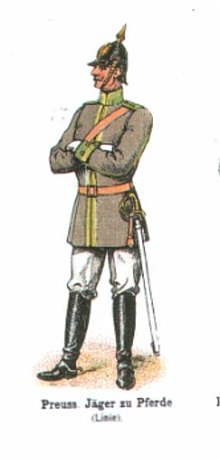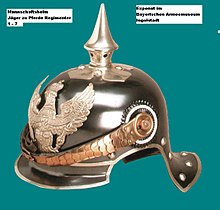Jäger-Regiment on Horseback No. 2
The Jäger Regiment on Horseback No. 2 was a regiment of the Prussian Army . The hunters on horseback are units of the light cavalry , which were mainly used for reconnaissance and security tasks.
Organization and association membership
- Commander: Lieutenant General Ernst Wagner
- 38th Cavalry Brigade in Erfurt
- Commander: Major General Paul Weinschenk
Lineup
In 1900, the Highest Cabinet Ordre (AKO) ordered a "Combined Jäger Detachment on Horseback" to be set up with two squadrons with a garrison in Langensalza . It was the XI. Assigned to Army Corps . The line-up was completed on October 1, 1900 (Foundation Day), and the troops were ready for action from that day on.
When the Reichstag approved the funds for the formation of three regiments of hunters on horseback in 1905 , the expansion of the previous detachment to the hunter regiment on horseback No. 2 began.The scaffolding formed the two previous detachment squadrons, the 1st and 2nd . Squadron, to which the following associations were assigned:
- the Guard-Jäger-Squadron on horseback from Potsdam as 3rd squadron
- the 3rd squadron of the Magdeburg Hussar Regiment No. 10 from Stendal as 4th squadron
- the 5th squadron of the Brunswick Hussar Regiment No. 17 from Brunswick as 5th squadron
The first commander of the regiment was Lieutenant Colonel von Brauchitsch. Langensalza was retained as a garrison.
uniform
The uniforms had the same pattern as the cuirassiers, but with the following changes:
- Gray-green Koller (from 1910) tunic with Swedish lapels, lapels and all advances light green, but epaulets in ponceau red as the badge color. Light green borders ran around the collar and lapels, which had a broad central stripe and narrow edge stripes in the same color as the badge. For officers, the trimmings consisted of gold or silver braid with narrow stripes in the color of the badge. Epaulets with regimental numbers.
- Field cap: Gray-green in color with light green stripes and lemon-yellow protrusions
- Helmet: Similar to a cuirassier helmet, made of blackened sheet steel with a dragoon eagle. Edges with nickel silver edging rails. Tip like dragoon helmet with clover-leaf-shaped attachment. (Officers with fluted tips like cuirassier officers.) Arched scale chain made of tombac .
- Cuirassier boots made of natural brown leather
- Lance flag white-black
First World War
After the mobilization on the occasion of the First World War , the regiment was moved to Lorraine , took over the border protection in the area of the 8th Cavalry Division (Royal Saxon) and secured in the advance area of the 6th Army .
From September 1914 the regiment moved to East Prussia and took part in the persecution battles in Poland and the Battle of Warsaw . It was mainly assigned with reconnaissance and reporting tasks, with minor skirmishes with Russian cavalry. In November 1914, the hunters took part in the Battle of Łódź . In the spring and summer of 1915 they were also used in the trench warfare between Courland and Düna . The years 1916 and 1917 brought the regiment no major fighting. Relocated to the west at the beginning of 1918, when the horses were surrendered, training for the cavalry rifle regiment began . Together with the Rifle Command 38, the transfer to the Guard Cavalry Rifle Division took place.
From the end of May 1918 the regiment fought near Reims and moved to the north in the second half of the year, where it stood out particularly in the fighting for St. Etienne.
With the 1st Army, the Guards Cavalry Rifle Division began the march back to the Antwerp-Maas position on November 4, 1918 , with parts of the regiment forming the rearguard. After the armistice , the regiment began to march back home on November 13, 1918, reaching the border at Dasburg on November 17. From December 5, the regiment was loaded onto Potsdam , from where it marched to the main cadet institute in Groß-Lichterfelde near Berlin.
The cavalry riflemen then took part in the fighting against the Spartakists in Berlin, which lasted until the spring of 1919. In April the regiment moved to the area of Zossen , where it was divided among the Reichswehr troops and ceased to exist.
- The 4th Squadron of the Reichswehr Cavalry Regiment 20 on August 9, 1919
- The remaining squadrons as 2nd battalion for Reichswehr Infantry Regiment 59
The tradition was taken over in the Reichswehr by the training squadron of the 7th (Prussian) cavalry regiment in Breslau .
Commanders
| Rank | Surname | vocation | Recall |
|---|---|---|---|
| Lieutenant Colonel / Colonel | Louis von Brauchitsch | October 1, 1905 | March 19, 1911 |
| Lieutenant colonel | Hermann Seul | March 20, 1911 | March 21, 1914 |
| Lieutenant colonel | Fedor von Müller | March 22, 1914 | April 30, 1918 |
| major | Albert Schoen | May 1, 1918 | 1919 |
literature
- Hugo FW Schulz: The Prussian Cavalry Regiments 1913/1914. Weltbild Verlag 1992.
- Jürgen Kraus : The German army in the First World War. Uniforms and equipment. Militaria Publishing House, Vienna 2004.
Individual evidence
- ^ Günter Wegmann (Ed.), Günter Wegner: Formation history and staffing of the German armed forces 1815-1990. Part 1: Occupation of the German armies 1815–1939. Volume 3: The occupation of active regiments, battalions and departments from the foundation or formation until August 26, 1939. Cavalry, artillery, pioneers, motor and driving departments, armored forces, traffic forces and intelligence departments. Biblio Verlag, Osnabrück 1993, ISBN 3-7648-2413-1 , p. 191.


